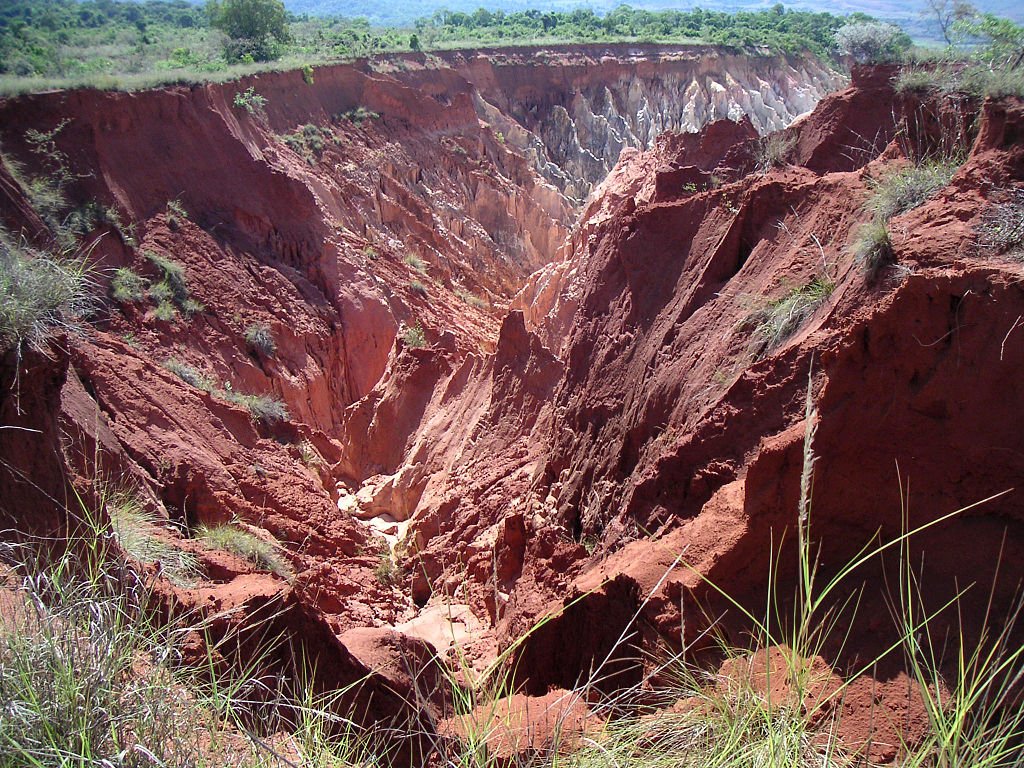Learning to Say ‘No’ to Risky Mega-Projects
"Madagascar erosion" by Frank Vassen from Brussels, Belgium is licensed under CC BY 2.0. Unmodified.
Scott Moore is a Harvard-trained political scientist who was formerly a top advisor to the U.S. State Department on China and the environment. He is now Director of the Global China Program at the University of Pennsylvania. Here, he teams up with ALERT Director Bill Laurance to voice concerns about the stunning proliferation of mega-projects worldwide, many being built under China’s controversial Belt & Road Initiative.
A year ago, scientists made what is now one of the rarest of discoveries: a new species of great ape, one of humanity’s closest relatives in the animal kingdom.
But scarcely have we become acquainted with our new relation, since named the Tapanuli orangutan, than it may disappear from the face of the Earth.
Fewer than 800 members of the species are thought to exist, all in an isolated group living in northern Sumatra. Unfortunately, the orangutans’ only home is also the site of a planned Chinese-backed hydropower dam.
The rare orangutan is far from the only species at risk from a global boom in big infrastructure projects that, if left unchecked, will devastate the natural world.
But the real tragedy is that their sacrifice may be in vain: many of the world’s mega-projects turn out to be bad for profits and people as well as the planet.
And while the world does need roads, railways, and dams, nations need to get better at deciding when and where they make sense – and how to say no when they don’t.
SURGE IN MEGA-PROJECTS
Over the past half-decade, countries across the globe have seen a surge in proposed mega-projects, thanks in large part to China’s Belt and Road Initiative, a multi-trillion-dollar plan to build roads, railways, pipelines, and ports from New Zealand to Nicaragua.
Such investment has politicians and investors across the globe salivating at the prospect of finally overcoming the bottlenecks that have long isolated developing from developed-country markets, and that many national leaders see as a route out of poverty for their people.
But the fact is, many mega-projects simply aren’t worth the risk to investors, host nations, or the environment.
Big infrastructure projects carry undeniable attractions for investors and politicians: they often stimulate trade and industry, and can help boost employment.
But the hidden costs are high. Research shows that the construction of roads, of which more than 25 million kilometers are expected to be built by 2050, devastate local environments by opening up previously-isolated areas to deforestation, mining, and land speculation.
Coming on top of an animal apocalypse — the recent reported loss since 1970 of 60 percent of the world’s wildlife — a global boom in infrastructure is likely to destroy much of what’s left of the natural world.
The devastation can be so great that Brazilian scientist Eneas Salati has claimed the best thing you could do for the Amazon rainforest is simply blow up all the roads.
BIG PROJECTS, HIDDEN COSTS
The hidden costs of mega-projects aren’t borne by the planet alone. A surge in cheap financing, especially by China, has increased the risk of “debt traps” for poor countries, locking them into financing projects they can’t really afford.
For example, Pakistan, Sri Lanka, Laos, and a number of Pacific Island nations are already teetering on the brink of financial insolvency.
Nor is infrastructure alone a solution for poor countries: contributions to growth can be undermined by widespread corruption.
Moreover, sudden influxes of foreign capital for infrastructure and extractive industries can rapidly inflate the local currency, destabilizing the economy while robbing other industries such as manufacturing, exports, and tourism of their competitiveness.
For investors, meanwhile, pursuing big infrastructure projects in fragile countries and environments can also be risky. Cost-benefit studies show that many mega-projects produce surprisingly poor returns.
Oxford University researchers have found, for example, that large hydropower dams regularly exceed cost estimates by 90 percent — and over half of big dams built since 1934 have performed so poorly they’ve become stranded assets.
Of course, investors aren’t entirely blind to such risks. One common tactic is to insist on favorable tax conditions, often while giving generous ‘incentives’ to politicians.
Such strategies have a way of coming back to bite investors and host nations. For example, in Papua New Guinea, open warfare has erupted among indigenous tribes as the financial realities and tax losses from a $19 billion natural-gas project funded by foreign investors have come to light.
Such conflicts are joltingly common in developing nations, and help illustrate the many underlying sources of risk for big infrastructure.
LEARNING TO SAY ‘NO’
Given these gauntlets of risk, the world must say no to many proposed mega-projects — as far too many are ill-conceived and dangerous.
Instead, decision-makers and investors should follow transparent science-based criteria to determine which infrastructure projects will really benefit people without trashing the planet.
Fortunately, we know enough now to red-flag the most high-risk projects — such as those in remote or wild areas, in epicenters of biodiversity, in locales prones to damaging floods or landslides, and in the dark shadows where corruption and economic disparity thrive.
Projects pocked with red flags can then be scrutinized carefully by international experts, greatly increasing public transparency.
Learning to say no to flashy mega-projects will mean making tough political and economic decisions.
But there is a very important silver lining. By freeing ourselves from our recent obsession with mega-projects, we can help ensure that investment flows to initiatives that promote shared prosperity and help protect the planet’s riches for future generations.


![Road-Elephants-Wild elephants climb expressway guardrails in Xishuangbanna NNR China.org.cn[1].jpg](https://images.squarespace-cdn.com/content/v1/51b078a6e4b0e8d244dd9620/1544703185995-R699JDVRBRXXN16LJMZJ/Road-Elephants-Wild+elephants+climb+expressway+guardrails+in+Xishuangbanna+NNR+China.org.cn%5B1%5D.jpg)


